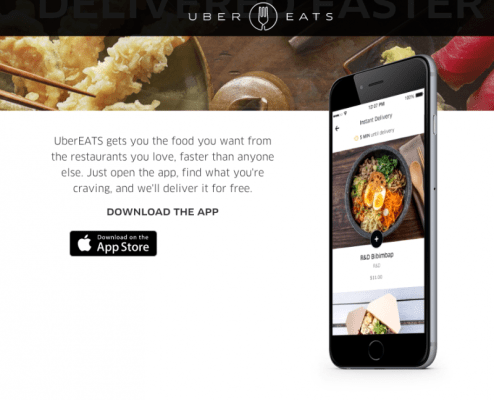Uber is taking the next step to push its well-funded brand into the prepared food delivery space — launching the UberEATS service as a standalone app today, in Toronto.
The UberEATS service delivers food prepared by local restaurants to users via Uber partners — aka the drivers who are selling rides via the Uber platform. So of course Uber is not preparing any food itself.
While Uber has been offering a prepared food delivery service for around a year and a half in several U.S. cities, as well as a handful of locations outside the U.S. (currently Toronto in Canada and Paris in France), the food delivery offering has been bundled into its ride-sharing app up to now.
This summer Uber put out an update to its main app which gave UberEATS a far more prominent position within the app. But it’s now going a stage further — testing the waters with a standalone UberEATS app.
Breaking out the app as a standalone offering is a bid to try to keep things super simple, according to Jason Droege, Head of Uber Everything, speaking to Wired.
Part of that process means reducing meal choice within the app for the “instant delivery” option (i.e. pegged to arrive within five to 10 minutes), which means users get no more than five menu items to choose from in total if they want a really quick food fix.
It’s still possible to browse full menus of local restaurants within the app, and select anything for a “regular” (i.e. longer) delivery time window — say half an hour or more. But Uber is evidently trying to encourage snappier lunch making decisions to drive more sales and discourage food-based indecision.
According to Wired, Uber chose Toronto as a testbed because the UberEATS service had already been popular there. It also professed confidence in its local operations team.
The service will still be competing with a number of existing app-based food delivery services, so it will be interesting to see how well the Uber brand travels when it comes to food.
The company’s ability to cross-promote standalone apps to its existing ride-sharing platform user-base suggests it won’t be hard for Uber to get its users’ attention for any apps it breaks out. But food delivery logistics can be a tricky business so a specialist food delivery startup, with dedicated processes and couriers, might prove more reliable at serving a pipping hot meal than a multitasking Uber partner who may just be driving around in their own lunchbreak.
At this point Uber says it hopes to learn from the Toronto launch before expanding the app to other cities — presumably depending on its performance. With plentiful competition in the food delivery space already Uber likely won’t be growing this business as fast as it’s been accustomed to on the ride-hailing side. Especially if its algorithm serves up too many cold meals.
Getting a person from A to B is one thing. But getting a perishable item delivered in a timely fashion, and handed over still looking good enough to eat, introduces additional complexities.
Even so, there will be a lot of food delivery startups watching the UberEATS app’s debut nervously, wondering whether the company is preparing to eat their lunch.
